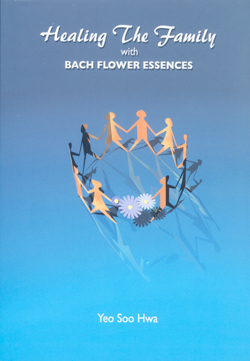|
Healing the Family with Bach Flower Essences
Book review by Jann Garitty
The above quotes from the book, Healing the Family with Bach Flower Essences , is a summary of the basic premise of the book, as well as the underlying philosophy of educating the reader in regard to using the original Bach essences in the context of self-help family therapy. It is, if you will, a psychological study and understanding of family dynamics that provides one with a “global” view based on essence “types.” The book is divided into three main sections:
This third section of the book, “Healing the Family,” warrants special attention as it deviates from many other books on the practical use of flower essences and puts forth the educational philosophy utilized by Soo Hwa as an author, that of teaching by personality or essence type. For example, in the section, “Resolving Family Issues,” Soo Hwa describes the essence/personality type of one of the members of a family from their point of view and contrasts it with other family members’ points of view, thereby illustrating the effects and misunderstandings that can occur. Topics with examples include communication, absenteeism, abuse, jealousy and rivalry, family feuds, transitions, and unforeseen circumstances. Further, the chapter “Growing Up as a Parent” is a characterization of parents as particular essence types describing their resulting impact and influence on children. Often times, there are misunderstandings relative to these types, especially if there is lack of communication in the family. The point is made that if parents address their own negative patterns and release them, they are better able to parent and support their children’s growth. Therefore, parents take greater responsibility for their own contribution to their childen’s behaviors. Essences that can be helpful for children, given their parents’ types, are also discussed. “Nurturing Your Child” brings forth some of the moral and ethical concerns in regard to parenting. Given the unique “essence” of each infant and child, the highest responsibility of a parent “is to protect that natural potential, nurture and grant it all the necessary conditions to grow and develop.” Adversely, the pattern of imbalance, if acted out by parents, would “censor their individuality and force them to be like [their parent].” Topics addressed in this section include infants and toddlers, “tackling change,” learning difficulties, social interaction, teenage years, and young adults. Here again, Soo Hwa utilizes the overview by essence type, and this helps to eliminate implied judgment of the children’s behaviors, gives understanding, and easily illuminates the exact remedy for the situation. The listing presented is not a comprehensive “repertory” by any means and not every possible situation is addressed. However, presented as it is, the specific situation or overall context in which an individual with a particular personality type exists, provides an understanding into the overarching knowledge of the remedies required for balance. The final chapter of the book, “Making Conscious Choices” is a philosophical discussion of the “importance of a higher level of self-awareness and conscious decision making in the family environment.” It also offers suggestions for raising children in an empowering way with loving respect.
Important to note and pertinent to Soo Hwa as an Asian practitioner, is a very interesting observation made by her as mentioned in the book preface written by Ann Holmblad: “Of particular interest with this book is its focus on those cultures, such as Asian or Scandinavian, for whom the freedom of self-expression is inappropriate and often denied as social and family norms. Soo Hwa points out how the Bach flower essences are especially relevant in such cultures, helping to alleviate conflicting feelings with the family by allowing individual members to release and rebalance their emotional distress.” Soo Hwa further discusses in the introduction her hope that the use of flower essence therapy will help to change in a healthy manner the “…generations of cultural habits and patterns that are no longer useful in this world we live in.” Healing the Family with Bach Flower Essences is a book that feels “fresh” even given the many books written on Bach flower essences over several decades. Written with straight forward heartfelt warmth and wisdom, it is easy to read and assimilate. It is clearly-presented and well-organized—even the choices of typography, titling, etc.—contribute to making it very accessible to the reader. Soo Hwa Yeo is a trained pharmacist (M.Sc.(Pharmacy)), Bach Foundation Registered Practitioner, Assessor, Teacher and Mentor with the Bach International Education Program. Visit her website . |

To install this Web App in your iPhone/iPad press ![]() and then Add to Home Screen.
and then Add to Home Screen.

 As implied in this review, one of the greatest strengths of this book is the repeated use and descriptions of essence or personality types—both those who are helping and those on the receiving end, whether in or out of balance—which reinforces the understanding of the essences and their practical uses. Studied and taken to heart, this is a tool that provides a thorough understanding of the essences rather than just providing a list of remedies and what they’re used for; it truly educates the reader providing underlying foundational knowledge rather than just serving as a “reference book.”
As implied in this review, one of the greatest strengths of this book is the repeated use and descriptions of essence or personality types—both those who are helping and those on the receiving end, whether in or out of balance—which reinforces the understanding of the essences and their practical uses. Studied and taken to heart, this is a tool that provides a thorough understanding of the essences rather than just providing a list of remedies and what they’re used for; it truly educates the reader providing underlying foundational knowledge rather than just serving as a “reference book.”
